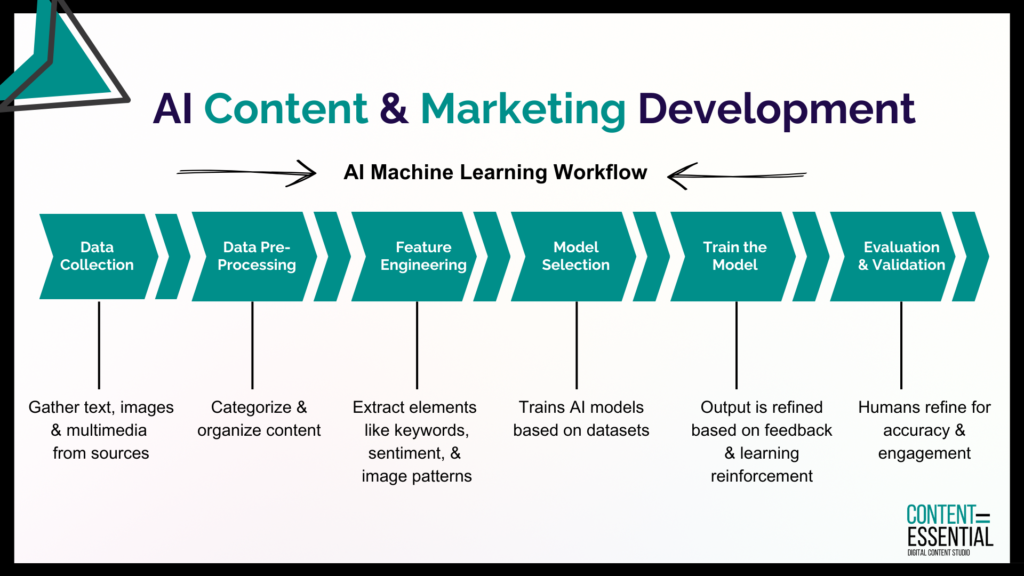Small business owners leverage AI to reduce costs, increase efficiency, and improve customer relationships. It’s a tool powering customer engagement and workflow processes in businesses and corporations.
When examining AI capabilities, owners will find that small businesses have access to sophisticated tools that can automate processes, enhance decision-making, and offer personalized customer experiences.
By using advanced techniques like machine learning, natural language processing, reinforcement learning, and time-series forecasting, small businesses can dramatically optimize their operations.
How AI Works
AI, or artificial intelligence, mimics how humans think and process information using algorithms – a set of well-defined instructions – to complete tasks. Through machine learning, AI uses those algorithms to improve online experiences and make decisions about content such as marketing data or financial information, and how it could be used.

Customer Engagement
Let’s start with AI-powered customer support.
You’ve likely come across companies that are using chatbots to begin conversations with customers. They identify the problem the customer is having and route them to the appropriate live agent who can then have a deeper conversation.
AI chatbot use natural language algorithms that deconstruct senses and extract intent and context. When a customer says “I want to pay my bill” or “I need a refund on my bill” both share the same intent of dealing with a billing issue. AI bots understand the variations in phrasing.
Chatbots may also split sentences into words or subwords to analyze meaning or identify the role of each word – like whether it is a noun or verb – to glean a deeper understanding.
A small e-commerce business could implement an AI-driven chatbot on its website that answers common questions about shipping, product availability, and returns. When customers inquire about specific products, the chatbot could also provide personalized recommendations based on previous browsing history or preferences.
The beauty company Sephora uses chatbots to offer beauty advice, personalized product recommendations, and even allows customers to book appointments.
Some chatbots like those used by LivePerson may have escalation mechanisms where after a few failed attempts at resolving an issue, the bot routes the conversation to a human.
✔️ Customer Engagement AI Hero: Zendesk
Personalized Marketing Using AI
Netflix has become known for its robust recommendation engine. It works by identifying patterns in user behavior. Its content-based filtering identifies program features such as genre to recommend similar shows or movies based on its customer’s past preferences.
AI also uses advanced predictive analytics or deep learning-based models to predict customer purchase behavior and optimize marketing campaigns. It can also segment customers into distinct groups to target each with tailored offers and personalized content based on shared characteristics and purchasing patterns.
A neighborhood gym can use AI-powered email marketing tools to send personalized workout tips, new class promotions, or special offers to members based on their activity history and interests.
A gym’s app can send push notifications or in-app messages suggesting specific classes or training sessions based on the user’s past bookings or workout patterns.
In another scenario, a local restaurant can segment its customer base into groups based on behavior (e.g., regular lunch visitors, dinner customers, or special occasion guests). AI can then send targeted promotional emails with personalized offers like “10% off your favorite pizza” or “Happy hour reminders.”
✔️ Marketing AI Hero: Hubspot
Financial Management
Using automated bookkeeping tools can help small business owners predict future cash flows with machine learning models. These models predict trends in revenue, expenses and can foresee dips and spikes in cash flow. That information allows businesses to pivot and plan accordingly.
AI-powered financial tools can identify anomolies can detect fraud by learning spending patterns and flagging transactions that fall outside the norm.
A bakery can use AI-driven software with machine learning capabilities to generate more accurate cash flow predictions, helping business owners anticipate slow months and plan for necessary cash reserves or funding.
For example, the AI can predict a dip in sales after a busy holiday season and recommend adjusting inventory orders to reduce costs, ensuring that the bakery has enough funds to cover fixed expenses.
✔️Financial Management AI Hero: Freshbooks
Social Media Campaigns
Using algorithms, AI tools can analyze comments on social media posts to gauge public sentiment – whether the responses are positive, negative, or neutral. They can track the performance of each post, determining the optimal post times, content that performs the best and which keywords drive the most engagement.
A community group could use AI-powered tools like Buffer or Hubspot to perform sentiment analysis on social media conversations, identifying the most pressing issues or emotions within the community. This allows the group to tailor their messages to be more empathetic and relevant to their audience.
AI can also segment the group’s followers based on their level of engagement (e.g., active participants, silent supporters, new followers) and automatically adjust communication to be more targeted. For instance, highly engaged members could receive updates on leadership roles or volunteer opportunities, while less engaged members could receive light-touch engagement, such as event invitations.
✔️Social Media Management AI Hero: Buffer
By integrating AI, small businesses can compete with larger enterprises, improving customer satisfaction, driving revenue, and reducing operational costs. The beauty of AI in small business operations is its ability to be scalable and adaptable, ensuring that businesses of all sizes can reap the benefits of these powerful technologies.